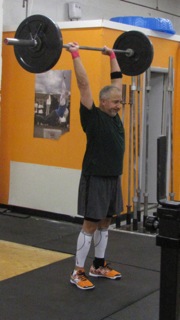Dress to Compress
By Susan Eastman Walton
Chances are you’ve seen runners wearing what look like dorky knee-high socks. True, beauty is in the eye of the beholder, but there is more than meets the eye here—regardless of one’s fashion sense. Actually, these runners are wearing compression socks or calf sleeves, which are becoming increasingly popular among athletes because of their ability to enhance performance, speed recovery, and prevent injuries.

JHPS CEO Ralph Walker uses RecoFit compression while CrossFittingJHPS CEO Ralph Walker uses RecoFit compression while CrossFitting
Compression’s origins are well-grounded in medicine science. Support stockings have long been prescribed post-surgery to assist in venous return and to prevent blood clots. By applying gradient compression from the foot and/or ankle, the blood is encouraged back up the leg to the heart. While one’s body is designed to do this on its own, a little extra help can go a long way.
We humans have two circulatory systems—the cardiovascular system of arteries, veins, heart and lungs, as well as the lymphatic system, which is a major part of our immune system and is comprised of nodes, ducts, tissue, and vessels. Both aspects of the circulatory system must work in harmony for effective recovery and optimum health.
Circulation is normally aided by flexing muscles, which helps squeeze out waste by-products, lymph fluid, and de-oxygenated blood. Inactivity, the everyday effects of gravity, as well as vigorous exercise or trauma can cause fluid to pool in the muscles and surrounding tissue. The right amount of gradient compression (tighter at the bottom of the leg and becoming looser farther up) can promote better circulation and speed up recovery.
People who stand at their jobs, sit for long periods while traveling, or who are pregnant (which doubles a woman’s blood volume) understand how this pooling makes the lower legs swell and feel heavy. Wearing leg compression socks or calf sleeves can alleviate these symptoms. Athletes are figuring out that this works for them, too, because vigorous exercise causes muscle damage, including micro-tears. Inflammation is the body’s response to this damage. Compression helps reduce excessive inflammation that can interfere with the recovery process and helps reduce Delayed Onset Muscle Soreness (that feeling you get the day after a particularly hard workout).
Shin splints are another injury that compression can either prevent or accelerate the healing process. This slow-healing and painful condition in the shins is a common complaint of many athletes and is often caused by high-impact training, poor technique, or biomechanical issues such as pronation that strain the muscles surrounding the tibia. If left untreated, stress fractures can occur.
Athletes are also finding that compression provides better oxygen delivery—and energy—to busy muscles. This means muscles warm up faster, which prevents injuries and allows athletes to achieve a higher level of fitness faster. In addition, people who wear gradient compression clothing receive the added bonus of improved proprioception: the awareness of your body’s position and movement as well as how each part of your body works in concert with the others. The effect of compression on muscle groups allows athletes to focus better on those muscles working correctly.
Compression clothing also reduces muscle vibration. A study by the Human Performance Laboratory at the University of Calgary, Alberta examined how muscles work hard to not vibrate because vibration damages the tissues. But the body’s natural “damping” mechanism that reduces muscle vibration requires energy, and therefore increases fatigue. By taping 3-D accelerometers to various muscle groups of four athletes running on treadmills, the Calgary study measured EMG signals (the muscles’ electrical activity) related to heel strikes. The study showed that compression clothing dampens muscle vibration, thereby saving up to 8 percent in energy output. Think about how much energy that would save over a distance such as the 26.2 miles of a marathon!
If all this information makes you want to run out and buy something compressive, make sure it is sized properly. If it is too small, it will restrict—not promote—blood flow, and if it is too loose, you will feel little or no benefits. Follow the recommended sizing on the product’s packaging.
When you do have the correct product, compression can make a difference in your performance, recovery, and comfort, whether you are a serious athlete, a frequent traveler, or someone who is on your feet all day. Trust me—your feet and legs will thank you.
Susan Eastman Walton is the owner of RecoFit Compression Gear, based in Boulder, Colo.
JHPS is pleased to offer RecoFit compression sleeves. For more info, visit our RecoFit page at: https://johnhowardsports.com/FiTTE-Shop/index.php?route=product/category&path=70_92